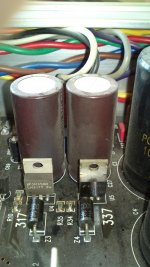Hi!
I`m currently having a problem with one of my amplifiers, a Hegel H1. When I power it up, it makes some pretty harsh, loud popping and crackling noises in my both my speakers. This goes on for some 2-3minutes, until it seems it`s gotten up to temperature.
So I popped it open today, while powered, hoping to find a blown cap, or a cold solder. However, before I started looking over the components, I decided to vacuum out some dust and hair that was in the amp. Luckily I did, cause when I vacuum around the power regulators LM317/LM337 the speakers start producing the same noise as on startup. I`m thinking the air being sucked in to the vacuum has a slight cooling effect on the regulators, and they start producing the noise as they get slightly colder? I don`t have any cooling spray atm., so I can`t try that, to verify that it is in fact a temperature-drop that is causing them to produce this noise. But I can provoke this noise every-time with the vacuum.
So, has anybody ever experienced this kind of behavior from LM317/337 before? Can they produce ripple/noise if they are faulty? I do also think they are running quite hot, the LM317 is running at about 71degrees C, and the 337 is at about 62degrees C, is this abnormally hot?
Regards
- Bjørn W
I`m currently having a problem with one of my amplifiers, a Hegel H1. When I power it up, it makes some pretty harsh, loud popping and crackling noises in my both my speakers. This goes on for some 2-3minutes, until it seems it`s gotten up to temperature.
So I popped it open today, while powered, hoping to find a blown cap, or a cold solder. However, before I started looking over the components, I decided to vacuum out some dust and hair that was in the amp. Luckily I did, cause when I vacuum around the power regulators LM317/LM337 the speakers start producing the same noise as on startup. I`m thinking the air being sucked in to the vacuum has a slight cooling effect on the regulators, and they start producing the noise as they get slightly colder? I don`t have any cooling spray atm., so I can`t try that, to verify that it is in fact a temperature-drop that is causing them to produce this noise. But I can provoke this noise every-time with the vacuum.
So, has anybody ever experienced this kind of behavior from LM317/337 before? Can they produce ripple/noise if they are faulty? I do also think they are running quite hot, the LM317 is running at about 71degrees C, and the 337 is at about 62degrees C, is this abnormally hot?
Regards
- Bjørn W
They should work OK at that temperature even if it's not ideal. I would expect dodgy fractured joints to be more likely, the heat cycling can literally pull a joint to pieces, especially if the leads can't move or flex on the topside of the pcb which depends on how the device is mounted. A magnifying glass might show the cracks around the lead/solder interface.
If it's not the solder, I wouldn't discount a decoupling cap gone low capacitance, and the LM317/337s are oscillating at VHF.
If it's not the solder, I wouldn't discount a decoupling cap gone low capacitance, and the LM317/337s are oscillating at VHF.
But wouldn`t a bad solder joint also produce this noise if I tap or wiggle the component? It seems only temperature decrease/increase will produce the error.. 😕
Here`s a picture of the area, the two diodes in front are 1.5KE36A, and the caps at the back are 1000uF/100V, and then there are 4 SMD-resistors around the feet of the regulators.
Here`s a picture of the area, the two diodes in front are 1.5KE36A, and the caps at the back are 1000uF/100V, and then there are 4 SMD-resistors around the feet of the regulators.
Attachments
But wouldn`t a bad solder joint also produce this noise if I tap or wiggle the component? It seems only temperature decrease/increase will produce the error.. 😕
Difficult to say, I've seen it go both ways and I seem to spend half my working hours trying to make intermittent faults happen. Looking at your pic, another thing springs to mind that I've seen a lot of is leaking electrolytics; i.e. those big ones may have deposited contaminants all over the regulator area and they would certainly give temperature related symptoms but not necessarily physical movement ones. Any funny smells? Cleaning with Ultrasolve is my usual fix, meths or isopropyl alcohol might be an alternative. The big caps may still measure OK even when leaking electrolyte by the way.
Last edited:
Does not look like the caps are leaking, but I`ll have to check the underside of the board. I can see some brown "spots" on the solder points for the resistors, but I figured that was just some residue flux from the soldering. Might be electrolytic fluid though. 😱
I will also try to get hold of some freezing spray, and try to just freeze the plastic packaging of the regulators, and not the connectors, to see if they produce the error. That way I`ll be more certain what is producing the problem, component or soldering. 😉
I will also try to get hold of some freezing spray, and try to just freeze the plastic packaging of the regulators, and not the connectors, to see if they produce the error. That way I`ll be more certain what is producing the problem, component or soldering. 😉
- Status
- Not open for further replies.
